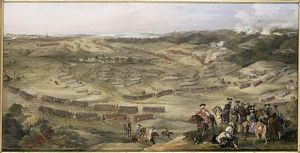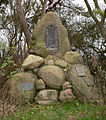Battle of Hastenbeck
| date | July 26, 1757 |
|---|---|
| place | Hastenbeck |
| output | French victory |
| Parties to the conflict | |
|---|---|
|
|
|
| Commander | |
| Troop strength | |
| 36,000 men | 60,000 men |
| losses | |
|
1,400 dead and wounded |
2,300 dead and wounded |
Western theater of war
Hastenbeck - Krefeld - Sandershausen - Lutterberg 1758 - Bergen - Minden - Gohfeld - Fulda - Korbach - Emsdorf - Warburg - Rhadern - Kampen Monastery - Langensalza - Saalfeld - Vellinghausen - Arnsberg - Wilhelmsthal - Lutterberg 1762
The Battle of Hastenbeck on 26 July 1757 was a battle of the Seven Years' War between the in personal union affiliated Electorate of Brunswick-Lüneburg ( "electoral Hanover") and the Kingdom of Great Britain against France .
Starting position
In May 1757 the French court had agreed to begin an offensive against Prussia and its allies with 105,000 men . At the end of the month, the army on the Lower Rhine already had 115,000 men due to Austrian contingents. The Rhine was crossed at the beginning of June, after which the western possessions of Prussia were occupied. On July 20, the French were able to conquer Bielefeld .
Prussia could only deploy 5,000 soldiers against the French army. The main burden was shouldered by Prussian allies, including the Electorate of Hanover , but also other Protestant imperial princes. The observation army formed from the other contingents had 47,000 men with 22 heavy artillery (27,000 Kurhannoveraner, 12,000 Hessen-Kasseler, 6,000 Braunschweig-Wolfenbütteler, 1,200 Schaumburg-Lipper and 800 Sachsen-Gothaer). The commander in chief was William Augustus, Duke of Cumberland . He was the son of George II , the Elector of Braunschweig-Lüneburg and King of Great Britain. Its main goal was to defend Kurhannover against French occupation. But despite his efforts, the French under Marshal d'Estrées were able to cross the Weser on July 16, 1757 .
Course of the battle
In order to push the French troops back behind the Weser line, Cumberland faced the battle at Hastenbeck on July 26, 1757, although the terrain was only known to him superficially. He positioned his army west of the elevation of the Schecken between Afferde via Hastenbeck to Obensburg on a battle line 6 km long. By skillfully setting up his troops in the hilly terrain, he made up for the disadvantage of the considerable inferiority of troops and cannons. The town of Hastenbeck, which was evacuated by its residents, was located in the middle of the fighting area about 300 meters from the Allied lines and was therefore exposed to destruction.
The morning of July 26, 1757 began with an artillery duel between the troops involved. The French General Chevert, unnoticed by the Allies, had approached the raising of the Schecken with his corps at Voremberg the night before . From there, at the beginning of the battle, he advanced with 18 cannons to the hill of the Obensburg, on which three Allied hunter companies were standing, and took their positions. Standing in the back of the Allies, the French troops shot them from above with their cannons. Soon the Allies recaptured Obensburg through Colonels von Breidenbach and von Dachenhausen and fired at the French positions with the cannons they found.
At noon, Marshal d'Estrées, who had observed the recapture of Obensburg from the battlefield, gave his troops the order to break off the battle. Shortly thereafter, the Duke of Cumberland gave his troops the order to withdraw. The orders were given at the height of the battle on the assumption that a quick retreat would save the army from annihilation. When Marshal d'Estrées realized with his presence of mind that the Duke of Cumberland was also leaving, he stopped his withdrawal and, for security reasons, did not pursue any further. This lost the battle for the observation army. The French army had suffered losses of 2,300 men, while on the Allied side the losses were only 1,400 men.
Effects
The consequences of the lost battle were far-reaching. Cumberland withdrew the observation army behind the Aller , thereby abandoning the fortress of Hameln . He commissioned the city's weak garrison regiment to offer the French troops the surrender, which took place on July 30, 1757. The French commander Marshal d'Estrées camped with his troops north of the battlefield. After intrigues at the Versailles court, he was replaced eight days after the battle. The French under their new Commander-in-Chief Louis Armand du Plessis, Duke of Richelieu , now occupied large parts of the Electorate of Braunschweig-Lüneburg and the Principality of Braunschweig-Wolfenbüttel. Finally the observation army, which had given up the Prussian contingents, was crowded together in the Stade area and cut off from supplies from Hamburg and Bremen .
Denmark then brokered negotiations between Cumberland and Richelieu about a declaration of neutrality. On September 8th and 10th, 1757, the so-called convention of Kloster Zeven was signed in Kloster Zeven . The electoral Hanoverian troops were to remain in the Stade area, while France occupied Hanover and the contingents of the other German princes were to be dissolved.
With the Convention of Kloster Zeven, there was no longer any army to oppose the French on their possible way to Magdeburg and Berlin . However, Richelieu initially only felt in the direction of Halberstadt ; the actual campaign was not to take place until 1758.
The events of the battle and its consequences are the subject of the novel Hastenbeck by Wilhelm Raabe (1899).
Above Hastenbeck on the Schmiedebrink as the center of the battlefield, a monument made of boulders was erected in 1907 on the 150th anniversary of the battle . It bears the inscription:
-
Here fought against the French on July 26th, 1757 Hanoverians, Brunswick, Hesse and Bückeburgers.
Erected in honor of the fallen on the 150th anniversary of the battle .
-
Here fought against the French on July 26th, 1757 Hanoverians, Brunswick, Hesse and Bückeburgers.
The destroyed buildings in Hastenbeck have been rebuilt, as evidenced by house inscriptions in the gable beams of several houses from 1758.
Sketch of the position of the battle of Hastenbeck west of the Schecken
Gable beam with house inscription ... burned by the bloody battaille on July 25th, 1757 ...
literature
- The Battle of Hastenbeck, not far from Hameln, the 26th Julius 1757 ( digitized version )
- Ernst Andreas Friedrich : The Hastenbeck Castle , pp. 207-209, in: If stones could talk. Volume I, Landbuch-Verlag, Hannover 1989, ISBN 3-7842-0397-3 .
- Günter Gebhardt: "The black day of Hastenbeck", in: Military affairs, economy and traffic in the middle of the Electorate and Kingdom of Hanover 1692–1866 . Studies on Lower Saxony State History, Vol. 1, ibidem (Edition Noëma), Stuttgart, 2010, pp. 45 ff. ISBN 978-3-8382-0184-9
- Olaf Groehler : The Wars of Frederick II , Berlin 1989
- Walther Mediger: Hastenbeck and Zeven. Hanover's entry into the Seven Years' War . In: Niedersächsisches Jahrbuch für Landesgeschichte 56/1984, pp. 137–166.
- Moritz Oppermann: The battle at Hastenbeck . CW Niemeyer, Hameln, 1957
- Moritz Oppermann: The Battle of Hastenbeck: For the 250th anniversary on July 26, 2007 . 2nd edition, CW Niemeyer, Hameln 2007 ISBN 978-3-8271-9304-9
- Friedrich R. Paulig: History of the Seven Years' War. A contribution to German history from 1740–1763 , reprint of the Frankfurt (Oder) 1878 edition: LTR-Verlag, Starnberg, 1988
Web links
- The Obensburg, the Schecken and the Battle of Hastenbeck at Hamelner-Geschichte.de
- Description of the battle and today's photos from the battlefield
- Historical site plans of the Battle of Hastenbeck at the Marburg Digital Archive ( Hessisches Staatsarchiv Marburg ):






